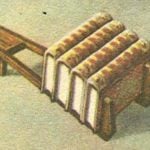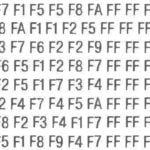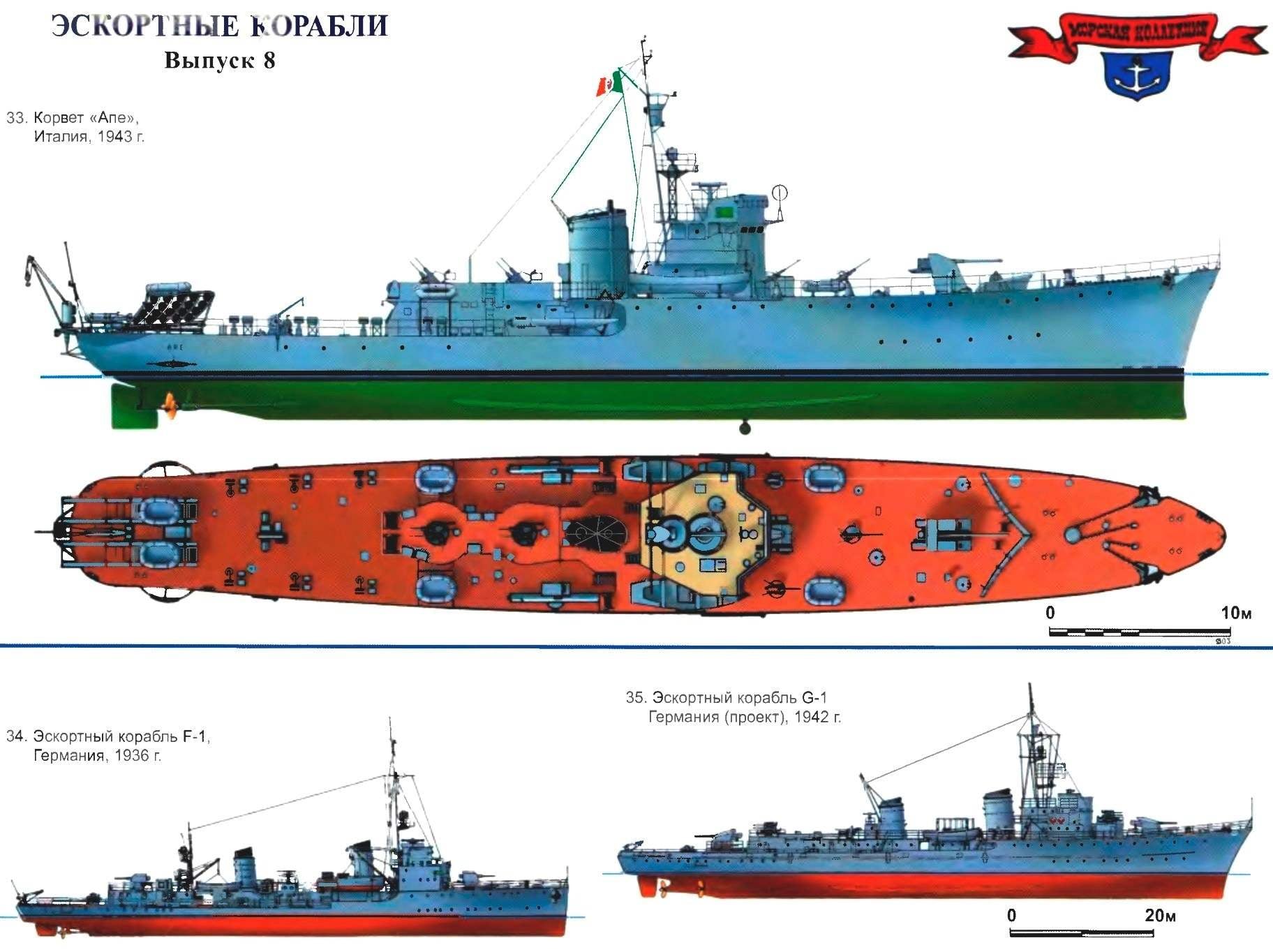 European Nazi Empire, Germany and Italy, showed a coincidence of interests on many issues. Was no exception and the construction of a naval fleet. Both the “leader” — Hitler and Mussolini — were eager to have powerful ships in the greatest possible number. But “nepredstavleniem” classes — in particular, the escort forces paid no attention. Both powers entered into world conflict with virtually complete absence of specialized combat vessels suitable for convoy and anti-submarine warfare.
European Nazi Empire, Germany and Italy, showed a coincidence of interests on many issues. Was no exception and the construction of a naval fleet. Both the “leader” — Hitler and Mussolini — were eager to have powerful ships in the greatest possible number. But “nepredstavleniem” classes — in particular, the escort forces paid no attention. Both powers entered into world conflict with virtually complete absence of specialized combat vessels suitable for convoy and anti-submarine warfare.
However, oddly enough, the patrol was among the first warships built under Hitler is the First and only series — F-bots — significantly different from their counterparts of similar purpose, created in other countries. With a rather small displacement (a little more than 700 MT) they are distinguished by the strong arms of 105-mm guns with a heavy (18-kg) shells, as well as high speed of 28 knots. The lack of torpedo tubes is not allowed to classify them as escort destroyers, especially since they are not considered themselves Germans appropriated the type of the vague designation of “fleet escort”. In fact, they were purely experimental vehicles, it is very unfortunate. The fact that the German designers have decided to apply them promising boilers with high pressure steam and at the same time to test the lines for future destroyers. Both in the project itself is absolutely not justified. High-performance boilers with a large amount of automation was appropriate for those classes of ships for which speed is a decisive element, for example, on the same fleet destroyers or cruisers (although, as we know from history, the sailors of the Kriegsmarine a lot of hardship to such installations). But for escort vessels as the main power plant has always been reliability and ruggedness. Considerations of weight savings and size have always faded into the background — no wonder the allies put on their sloops, corvettes and frigates, any machine, from diesels to have a completely obsolete by the time steam machines. The main thing — that the escorts can always give you the right course, and it is absolutely unacceptable that he hindered their escorted “the herd” due to accidents in the mechanisms! And this is exactly what happened with the F-bots in literally every campaign. Unsuccessful and “Menomonie” lines: waves flooded the deck from bow to stern. In General, to perform convoy work, the ships were totally unfit.
In an attempt to make them anything useful half of (F-1 to F-4 and F-6) was rebuilt, extending the casing at 4.5 m, bringing the total displacement up to 1150 t In three of them (F-1, F-Z and F-6) at the same time extended the forecastle to the stern, making them flush-deck. This resulted in many additional areas, and renamed to “Libelle”, “high” and “Kanigen Louise”, they have until the end of his career he served as a ships tender. The last two died under allied bombs, and “Libelle”, renamed the “Yagd”, after the war, initially served as floating headquarters for the German Commission for demining, and was then transferred to France where he soon sent for scrap. The same fate befell the F-8 and F-10, which, respectively, the British and Americans. Another patrol, F-2. also caught in the hands of the British, was put on the bottom during a training exercise fleet near Scapa Flow, like its sibling the F-7, which the Soviet Union and became a ship-goal is 225.
After the first military successes that led to the capture of Norway, Denmark and France, before the Kriegsmarine stood not planned initially, the objective of promoting coastal communications and the protection of the coast of the occupied territories. British and Soviet submarines, aircraft and torpedo boats allies became greater and greater threat. Designers immediately modified the pre-draft gunboats, creating a “fast patrol boat” of the type G. On paper it looked very ambitious: strong artillery armament was supplemented with modern sonar and anti-submarine equipment. “Highlight” was the presence of even light and primitive, but still of a helicopter in future one of the main enemies of the submarines. However, despite all the advantages of the project, the shipyards of Germany, could not find opportunities and allocate resources for its implementation. The real work was done only on the G-1, the construction of which started only in late 1942. But in July 1943, the British bombers turned the alleged first-born German escort forces in the wreckage, along with boathouse, in which he was. For G-2, G-5 and G-6 managed to collect a number of materials, but it did not come even to bookmark.
So, the story of escort ships of the Fuhrer ended in a fiasco. But “looting” in the shipyards of the defeated countries were much more successful. The main source of fast patrol boats (Schnelle Geleitfahrzeuge, or abbreviated to SG) became a French shipyard. Four mother ships seaplane were in a state of readiness by about a third, have undergone significant restructuring. They were 105-mm gun, antiaircraft machine guns and mortars. All four participated actively in the fighting; up to the end of the war survived only two ships.
In addition to these major units in the course went all sorts of “fines”. The restructuring was carried out, in particular, the French aviso — 900-tonne ships, with diesel engines, which allowed (according to calculations) to develop speed up to 20 knots. Each of them managed to hoist a few 105-millimetrovogo and up to twenty anti-aircraft guns. All four are included in the system (SG-14, -15, -21 and -22), was killed in the war. A similar fate befell relatively large (2,300 t) of the network frontier “Gladiator”, referred to as the “Corvette air defense” SG-18 sunk in Toulon as a result of the RAID allies in February 1944.
Among the captured German ships the most valuable was the Dutch coastal escort court program in 1938 (sometimes referred to as gun-boats). This program was supposed to build seven units, possessing excellent performance characteristics. The project’s developers managed to combine powerful weapons (twin 120-mm semi-automatic installation in armoured turrets, 40mm guns and anti-submarine mortars) with a very decent armor: 60 mm belt and 35-mm deck that is not much different from booking such cruisers as the Soviet “Kirov” or the Italian “Bolzano”! The propulsion system was to consist of diesel engines of the company “Babcock & Wilcox” with a capacity of 3500 HP and a design speed to be 18 knots.

33. Corvette “Up”, Italy, 1943
Built by “Napalechniki”. The standard displacement of 660 tons, full 730 t maximum Length of 64.35 m, beam of 8.71 m, draught of 2.53 m. Capacity twin-shaft diesel installation HP 3500, speed 18 knots. Armament: one 100-mm universal gun, seven 20-mm guns, one 450-mm twin-tube torpedo tubes, ten mortars. Just in 1942-1943 built 45 units, some of which are completed by the Germans.
34. Escort ship F-1, Germany, 1936
Built at the shipyard “Germany”. Displacement standard 715 t, 1030 t full Length most of 76.1 m, width 8,8 m, draught of 2.59 m. Capacity twin-shaft steam turbine 14 000 HP, speed 28 knots. Armament: two 105 mm guns, four 37-mm and four 20-mm machine gun. Only in the years 1935-1936 built ten units (R-1 — R-10).
35. Escort ship G-1, Germany (project), 1942
Built at the shipyard “Stalken” in Hamburg. The standard displacement of 1360 tons, full 1750 T. maximum Length 87 m, width 11 m, draft 3,43 m. Capacity three-shaft steam turbine 6750 BHP, speed 21 knots. Armament: four 105-mm guns (two twin installation, later replaced by two single), four 37-mm and eight 20-mm machine guns, a helicopter, four mortars and the release gear. It was planned to build 24 units (G-1 — G-24), however, really only laid the lead ship.
Before the war, managed to lay only three patrol, the Dutch never had time to name. Experts Kriegsmarine begun their putting into operation immediately after the capture of the Netherlands in 1940. As the English engines, of course, left for the English channel, they had to fit less powerful motors, which allowed to develop only 15.5 site. Became completely German and anti-aircraft weapons. Actively used after the entry into operation, patrol of “K” at the end of the war suffered heavy losses. K-1 and K-2 were killed from allied air. K-2 then managed to raise, however, during the tow, he again sank. In 1946, the ship lifted again, however, his condition was so bad that he was immediately sent for scrapping. Only K-3 survived captivity and returned to their real owners. Renamed “van Speyk” he in 1953 he got a new machine and was in service as escort ship until 1960.
But the captured ships still not enough to cover for the numerous convoys. Therefore, in the course went purely civil court. For example, as escortyou found a use for even fructuosa relatively small vessels Dutch, German, English and French buildings. They put two or three 105-mm guns and two dozen anti-aircraft guns. Needless to say, these clumsy “galoshes” is not well suited for anti-submarine warfare (at the nominal speed of 15 knots they were forbidden to develop more 11-12), but to some extent they can protect their wards against attacks from the air.
However, “bananovozy” belonged to a kind of anger convoy forces of the Third Reich. To guard against submarines in the Baltic, the North sea and in Norwegian waters soon had to mobilize all that was kept afloat and was able to make the installation of artillery without the risk of sinking from his own shots: coasting steamers, trawlers and drifters, big boats. Most of them received the proud classification “UBoot Jager” — hunter-submarine warfare (abbreviated as “Uj”), but in the encounter with the submarines their chances of victory looked very doubtful.
In the Mediterranean the status of escort forces was very similar. Admirals Duce was not more agile than their German colleagues. By the beginning of the Second world war in their possession were only four ships suitable for at least for the full anti-submarine warfare and escort transports.
Meanwhile Italy before the war had designed a couple of good patrol — though not for its fleet and for the Iranian. In the 1930s Persia, which was intensively flirted with almost all the leading European powers, with the renewal of the fleet bent to the service of the Duce. The order included the construction of four small boats, six large diesel patrol boats, the Royal yacht finally, two sloops — “Babr” and “Palang”. The last Italian engineers first used a relatively powerful diesels, having received useful experience, used later in the war. But the fate of both ships was equally sad: in August 1941 the British army and fleet entered the South of Iran, and the sloops of the Shah went down under the fire of the English sloop “Shoreham” and the Australian “Yarra”.
After the war the Italians managed to find a good option. They decided to focus on the construction of small, so — cheap units, production of which could be deployed in large numbers even at a very modest capabilities of private industry. Rightly judging that in the Mediterranean it is not necessary to use the ocean patrol, the Italians limited the cruising range of the corvettes of the “APE” 3000 miles — “for eyes” enough to the most distant communications. The technical solutions and the armament was thought out very carefully. So, in addition to the main diesel propulsion system there was a pair of electric motors with capacity of 150 HP and battery — exactly like in a submarine! Patrol could move almost silently at speeds of 5-6 knots for three hours, carefully and without any interference by listening to what’s going on under the water. The result is an underwater enemy was losing its main advantage — less noise of its engines compared to the pursuing surface ship. The arms of the 600-ton Corvette included everything we needed: 100-mm gun and antiaircraft machine guns, and, of course, for mortars depth charges, and also — which is very unusual — 450-mm torpedo tube. The latter could be useful in combat in the surface position of the submarine (especially when silent stalk) and also created a certain threat, even if hypothetical, any surface vessel of the enemy.
Good results and has made corvettes. The first of them that entered into operation during the year before the surrender of Italy, managed to sink four British submarines, against the background of more than modest success of the fleet of the Duce looks like a big victory. After the fall of the fascist regime and the German occupation of Northern Italy (where it was built almost all combat ships) corvettes of the “APE” were under the Kriegsmarine flag. The first couple joined in operation “Camoscio” and “Antelope”, got the numbers Uj-and Uj 6081-6082. They died together: a night in August of 1944 they were sent to the bottom of the American destroyer “Endicott”. Besides them, the Germans requisitioned two more ready Corvette and added nine more. Most of them died under the bombs of the allied air, and another pair, Uj-202 and Uj-208 (started construction as the Italian “bombard” and “Tupelo”), came under fire from two British escort destroyers “hunt”. The Germans planned to continue a program of using ships of the former ally. Another eight units were in the final stages of completion, and scuttled by the Italians in 1943, “Persephone”, “Euterpe” and “Egeria” was raised and put on the repair. However, none of them failed to serve new masters. The allied landing in the Apennines soon finished using the “good of others”. The share of the former owners still have a Baker’s dozen corvettes served in the Navy post-war Italy until the early 1970’s and enjoyed a very good reputation.
V. KOFMAN
Recommend to read
 SHELF STAND
SHELF STAND
Now even at primary school pupils the abundance of tutorials and various secondary sources. So the books were always at hand and at the same time did not create the mess table, make this... PROGRAMMABLE CODE
PROGRAMMABLE CODE
In technical literature there are many publications on improvised electronic code locks — variety of complexity and management that is performed on chips as small and medium scale...
 European Nazi Empire, Germany and Italy, showed a coincidence of interests on many issues. Was no exception and the construction of a naval fleet. Both the “leader” — Hitler and Mussolini — were eager to have powerful ships in the greatest possible number. But “nepredstavleniem” classes — in particular, the escort forces paid no attention. Both powers entered into world conflict with virtually complete absence of specialized combat vessels suitable for convoy and anti-submarine warfare.
European Nazi Empire, Germany and Italy, showed a coincidence of interests on many issues. Was no exception and the construction of a naval fleet. Both the “leader” — Hitler and Mussolini — were eager to have powerful ships in the greatest possible number. But “nepredstavleniem” classes — in particular, the escort forces paid no attention. Both powers entered into world conflict with virtually complete absence of specialized combat vessels suitable for convoy and anti-submarine warfare.



